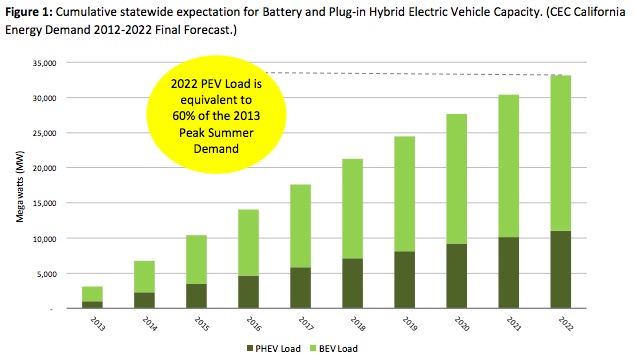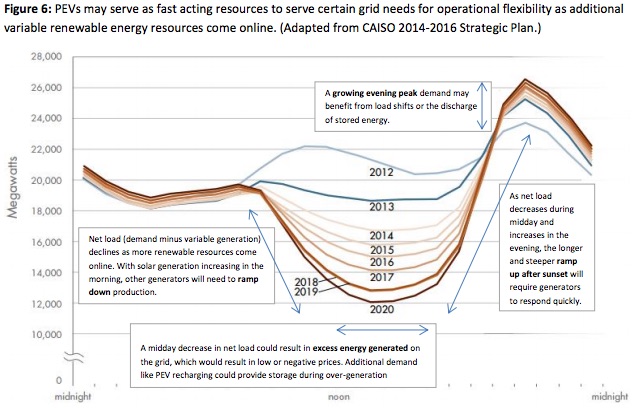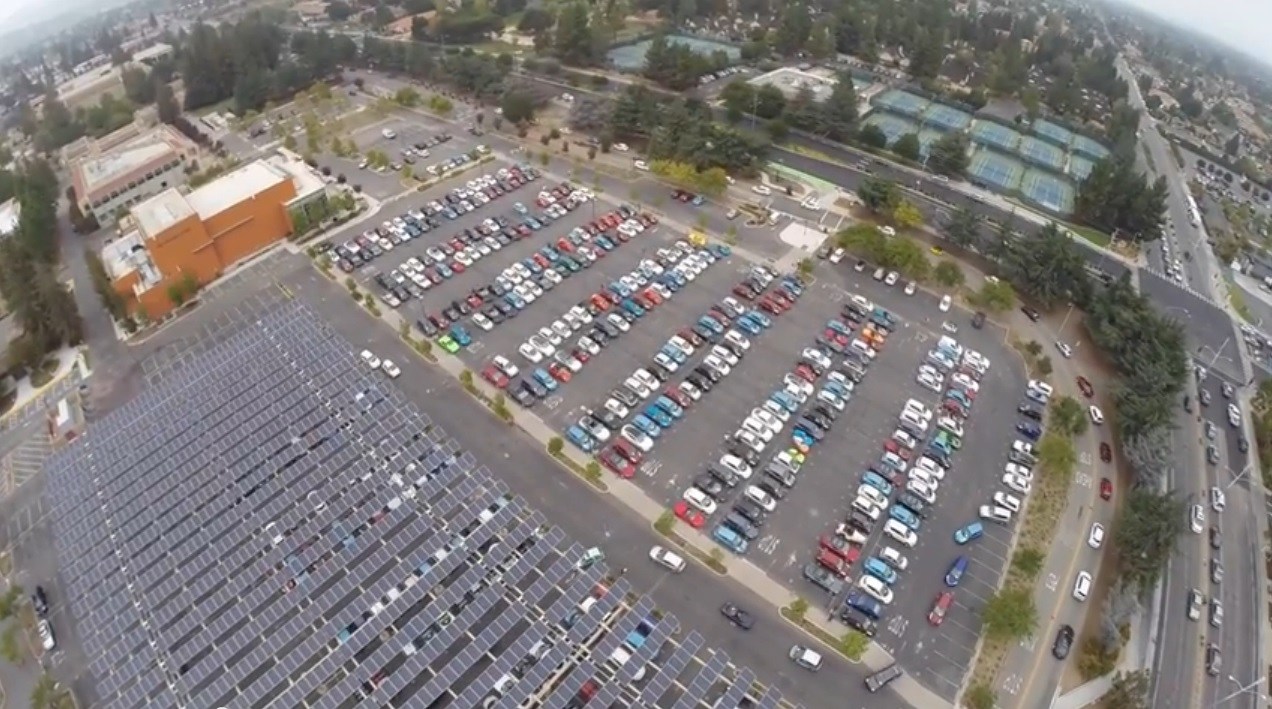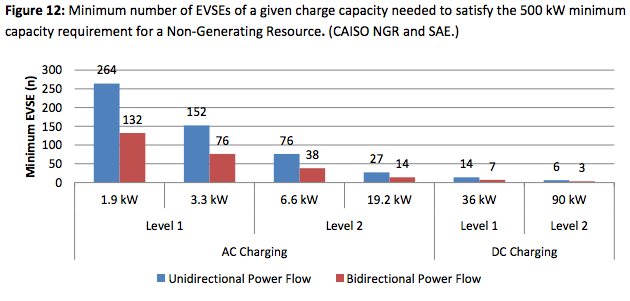Date: Mon Jan 04 2021 13:23:28 GMT-0800 (Pacific Standard Time)
Plug-in electric vehicles are proliferating in California. Their adoption is essential for the transformation of California's transportation system. However, their nature as mobile electrical loads places a challenge in front of electrical system coordinators.

As plug-in electric vehicles become more common, they'll simply take a larger and larger presence in California's electricity market. The paper suggests this is not a problem - so long as plug-in electric vehicles are situated as grid resources.
The paper notes that most "cars" have a low utilization factor. The average car spends 4% of its day being driven, and sits idle the rest of the day. Obviously that's not true for all vehicles - taxi's for example spend all day being driven, as do delivery trucks and so on. But the typical passenger vehicle is parked most of the time.
As we move to electric vehicles that battery pack, a.k.a. energy storage unit, is likewise being underutilized. Regulators are eyeing these battery packs and pondering how to use them for grid stabilization and perhaps improving utilization of solar power.
A framework to characterize vehicle-grid-integration and help understand the regulatory barriers to the use of electrified transportation as grid resources is discussed:
- The capability of the resource to provide power to the grid in addition to managing its power draw;
- The alignment of the objectives of the various actors (a vehicle owner, an electric charging station operator, and the facility at which they are located) involved with provision of power to or from the resource; and
- The provision of grid services from an individual or an aggregation of resources.
Solving for the Duck Curve

A related problem is that growing solar power adoption is challenging California's electricity grid. By 2020 it's expected there will be so much solar power that fossil fuel electricity simply will be unnecessary -- DURING THE DAY. That's great because solar electricity is extremely clean. But what about when the sun sets, and there's still stiff electricity demand during the evening? Will the fossil fuel power plants still be required, and how will they ramp up to provide evening electricity?
One idea is for energy storage units - including those built into electric cars - to timeshift solar electricity generated during the day to be consumed in the evening.
PEVs may be able to help meet emerging system needs at a lower cost than stand-alone storage or flexible thermal generation. For example, these needs are expected to vary throughout the day. In the mornings, the grid needs flexible load to absorb the increase in solar generation. PEVs that are plugged in and charging at the workplace could absorb this over-generation from solar PV systems, reducing the magnitude of the evening ramp. In the afternoon hours, the grid is expected to need load to curtail in response to solar variability and changes in temperature. PEV charging could respond to grid signals by momentarily curtailing load to avoid negative impacts on the distribution equipment. In the evening, the grid is expected to experience a rapid drop off in solar generation prior to the time that home load increases to the evening peak. PEVs could help provide regulation support, or even serve to reduce peak load through the use of bidirectional DC inverters to deliver energy to the grid to reduce peak demand. At night, the grid will be vulnerable to spikes in wind generation. Nighttime PEV charging could be signaled to increase its charge rate to mitigate changes in system voltage.
Framework for Vehicle-to-Grid integration
Direction of Power Flow: At the point where a plug-in electric vehicle connects to the grid, which way does the power flow? This may seem like a daft question because of course when the on-board charger is active, electricity is flowing into the car. However the report eyes two variations to this simplistic model:
- Variable flow into the car: If the car is characterized as a "controllable load" which the Utility companies can coordinate, it becomes a grid asset similar to demand response assets. Under "demand response" the utilities can, if load on the grid is too high, command certain devices to shut off. Electric car charging can be similarly controlled because a connected charging station can receive commands and either decrease or increase the charging rate.
- Bi-directional flow: Vehicle-2-Grid means the car can also act as an energy storage unit, supplying electricity to the grid if necessary.
Geographic Resource Aggregation: A single electric car responding to coordination commands from the utility companies won't make much impact on the grid. The on-board energy storage unit is simply too small. But, gather a bunch of plugin electric vehicles and coordinate their actions, and they can become a significant electrical system resource.

For example - this picture was taken September 28, 2013, at De Anza College in Cupertino California. It's important not for the solar array, but because every car in this parking lot is an electric car. The event was the largest "parade" of electric cars (officially certified by the Guinness Book of World Records) comprising 507 electric vehicles. If you sum them together that's 15 megaWatt-hours of electricity storage capacity in this one parking lot.
How long before it will be commonplace that the majority of vehicles on the road, or in parking lots, are electric?
California's regulators have a requirement that "non-generating resources" supplying electricity to the grid must be at least 500 kiloWatts in capacity. Below that threshold the resource must be controlled via an Aggregator.

This chart shows the number of charging stations of a given capacity required to meet the 500 kiloWatt threshold.
Key Regulatory Questions
Where is the "resource"? How do we define the location of the "resource" (in this case, an electric vehicle)? This may seem daft because the resource is the car, isn't it? What if you define the resource as the charging station? A mobile object like a car is more difficult to coordinate as a grid resource. Should the car have an on-board utility meter? How do you settle payments when the car is moving between one utility service area and another?
It's simpler from a regulatory perspective to define the "resource" as a charging station. The paper suggests they do not move, but of course there are mobile charging stations.
It's also possible to involve an "Aggregator" who coordinates the charging of multiple electric cars as a grid asset.
What is the utility role in aggregating resources?
Should the utility companies act as the aggregator? Or should third-party companies fill that role?
Utility as the Sole Aggregator: Under this scenario, the utility would be the sole entity responsible for aggregating vehicles. The utility would be responsible for enrolling customers and the program would provide incentives for customers to allow the utility to control its charging or discharging. The utility would use this control similar to scheduling coordinator rights to provide grid services to the wholesale market, while meeting the local needs of its service territory.
Utility as a Meta-Aggregator: Under this scenario, a non-utility third party aggregator serves as the intermediary between the customer and the utility. The utility aggregates the grid services and manages the services they can provide to the distribution system and the wholesale market. Just as the utility has no direct interaction with the customer, the aggregators would have no direct interaction with the wholesale market. Utilities would bid in all vehicles in their service territory as one resource into the wholesale market, and then direct aggregators to fulfill the wholesale market commitments.
Competitive Aggregation Market without Utility Participation: A third option is to have utilities play no role in aggregation. Non-utility aggregators would be solely responsible for aggregating vehicles to provide services to both the wholesale energy and ancillary services market and to the utility for distribution system benefits. In order to provide services to the distribution system, the utility would have to develop price signals that capture the costs and benefits from PEV charging and grid services. It would also need to develop a means of communicating these price signals to aggregators and customers. Capturing utility benefits and allowing third-party wholesale access for the same resource would introduce the need to establish rules that allow these two functions to co-exist, as described above.
- Retrieved From: CPUC (Sept 5, 2016)
